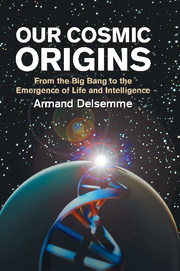Book contents
- Frontmatter
- Contents
- Foreword
- Preface
- Acknowledgments
- 1 Locating humans in the Universe
- 2 The race toward complexity
- 3 The stellar alchemy of metals
- 4 The formation of the planets
- 5 The emergence of life
- 6 The history of life
- 7 The awakening of intelligence
- 8 The other worlds
- 9 Perspectives
- APPENDIX A The standard model of the physics of elementary particles
- APPENDIX B Symmetry in physics
- APPENDIX C The strange role of time in relativity
- APPENDIX D The measurement of long time spans and the age of the Universe
- APPENDIX E The standard model of the Big Bang
- APPENDIX F The cause of the Big Bang and inflation
- APPENDIX G Chirality
- Glossary
- Bibliography
- Figure index
- Table index
- Name index
- Subject index
APPENDIX F - The cause of the Big Bang and inflation
Published online by Cambridge University Press: 05 August 2012
- Frontmatter
- Contents
- Foreword
- Preface
- Acknowledgments
- 1 Locating humans in the Universe
- 2 The race toward complexity
- 3 The stellar alchemy of metals
- 4 The formation of the planets
- 5 The emergence of life
- 6 The history of life
- 7 The awakening of intelligence
- 8 The other worlds
- 9 Perspectives
- APPENDIX A The standard model of the physics of elementary particles
- APPENDIX B Symmetry in physics
- APPENDIX C The strange role of time in relativity
- APPENDIX D The measurement of long time spans and the age of the Universe
- APPENDIX E The standard model of the Big Bang
- APPENDIX F The cause of the Big Bang and inflation
- APPENDIX G Chirality
- Glossary
- Bibliography
- Figure index
- Table index
- Name index
- Subject index
Summary
At the end of Chapter 1, it was mentioned that asymmetries in all the forces of nature disappear at extraordinary short distances, and that all force constants converge toward a single value.
Since the nuclear forces (strong and electroweak) are confined inside the atomic nucleus, the symmetry breaking of the forces must be produced by a phenomenon that takes place within the size of the nucleus (incidentally, this is what sets the nuclear size). The symmetry breakdown causes a change of state.
Changes of state, including familiar ones among solids, liquids and gases, imply a change in the symmetry properties. Ice forms crystals whose symmetry differs from that of water. Microscopic symmetries in the positions of atoms are not the same in liquid water and in steam. On the other hand, ice that turns into water absorbs heat without changing its temperature; it is the latent heat of the change of state. This latent heat arises from the entropy change coming from the symmetry change from ice to water. Moreover, while cooling, water often reaches a temperature below its freezing point without immediately solidifying: this is called supercooling.
Breaking of the original symmetry of all the forces has begun between rows 7 and 8 of Table E.1. About 10-35 seconds after the Big Bang, it can be assumed that the gravitational force had begun to fall in strength, followed by the decoupling of the strong nuclear force from the electroweak force.
- Type
- Chapter
- Information
- Our Cosmic OriginsFrom the Big Bang to the Emergence of Life and Intelligence, pp. 293 - 294Publisher: Cambridge University PressPrint publication year: 1998

